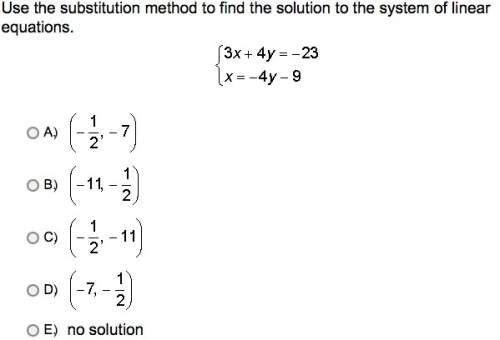
Mathematics, 02.07.2019 00:20 loll9416
Use the definition to find an expression for the area under the curve y = x3 from 0 to 1 as a limit. lim n→∞ n i = 1 r (b) the following formula for the sum of the cubes of the first n integers is proved in appendix e. use it to evaluate the limit in part (a). 13 + 23 + 33 + + n3 = n(n + 1) 2 2

Answers: 1
Another question on Mathematics


Mathematics, 21.06.2019 18:00
Given: and prove: what is the missing reason in the proof? given transitive property alternate interior angles theorem converse alternate interior angles theorem
Answers: 1

Mathematics, 21.06.2019 21:30
Alcoa was $10.02 a share yesterday. today it is at $9.75 a share. if you own 50 shares, did ou have capital gain or loss ? how much of a gain or loss did you have ? express the capital gain/loss as a percent of the original price
Answers: 2

Mathematics, 21.06.2019 22:20
1. 2. ∠b and ∠y are right angles. 3.? 4.? which two statements are missing in steps 3 and 4? ∠x ≅ ∠c △abc ~ △zyx by the sas similarity theorem. ∠b ≅ ∠y △abc ~ △zyx by the sas similarity theorem. = 2 △abc ~ △zyx by the sss similarity theorem. = 2 △abc ~ △zyx by the sss similarity theorem.
Answers: 2
You know the right answer?
Use the definition to find an expression for the area under the curve y = x3 from 0 to 1 as a limit....
Questions


Social Studies, 07.01.2021 20:30

Biology, 07.01.2021 20:30




Social Studies, 07.01.2021 20:30

Mathematics, 07.01.2021 20:30

Mathematics, 07.01.2021 20:40








History, 07.01.2021 20:40

Social Studies, 07.01.2021 20:40

Mathematics, 07.01.2021 20:40

Computers and Technology, 07.01.2021 20:40

 subintervals of equal length
subintervals of equal length  :
:![[0,1]=\left[0,\dfrac1n\right]\cup\left[\dfrac1n,\dfrac2n\right]\cup\cdots\cup\left[1-\dfrac1n,1\right]](/tpl/images/0040/5758/7f423.png)
 where
where  is given by the sequence
is given by the sequence
 . Then the definite integral is equal to the Riemann sum
. Then the definite integral is equal to the Riemann sum






